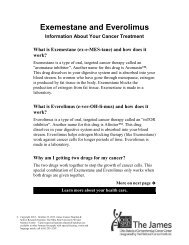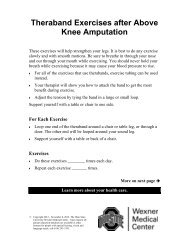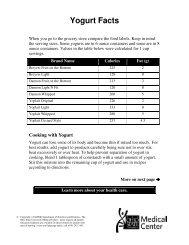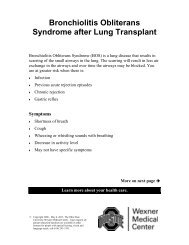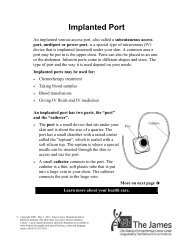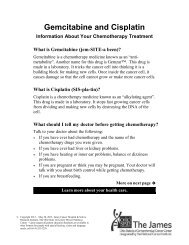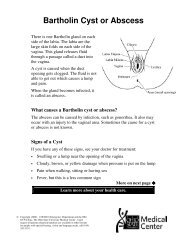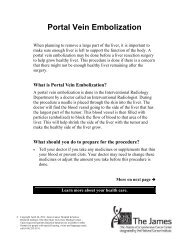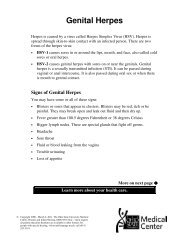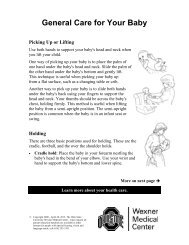Possible Problems with Peritoneal Dialysis - Patient Education Home
Possible Problems with Peritoneal Dialysis - Patient Education Home
Possible Problems with Peritoneal Dialysis - Patient Education Home
Create successful ePaper yourself
Turn your PDF publications into a flip-book with our unique Google optimized e-Paper software.
<strong>Possible</strong> <strong>Problems</strong> <strong>with</strong><br />
<strong>Peritoneal</strong> <strong>Dialysis</strong><br />
There are some possible problems you may experience <strong>with</strong> peritoneal<br />
dialysis (PD). You will be able to care for many of the problems yourself;<br />
however, some problems are emergencies and need medical care right<br />
away.<br />
PD Emergencies<br />
• Cloudy bags<br />
• Leaking from your catheter exit site<br />
• Catheter adapter falls out or comes apart<br />
• Contamination of any part of your PD system<br />
• Your catheter falls out<br />
• Hole in your catheter<br />
Infections and <strong>Peritoneal</strong> <strong>Dialysis</strong><br />
Infections are one of the most common problems seen <strong>with</strong> peritoneal<br />
dialysis (PD). Most infections can be prevented. Bacteria are normally<br />
present in many parts of your body, such as your skin, nose and bowel. To<br />
prevent the spread of these bacteria to unwanted areas, wash your hands<br />
<strong>with</strong> an antibacterial soap for 20 seconds and dry them <strong>with</strong> a paper towel.<br />
Make sure your hands are clean before any procedure.<br />
© Copyright 2000 - August 6, 2010. The Ohio State University<br />
Medical Center, <strong>Dialysis</strong> Center - Upon request all patient education<br />
handouts are available in other formats for people <strong>with</strong> special<br />
hearing, vision and language needs, call (614) 293-3191.<br />
Learn more about your health care.<br />
More on next page
Page 2<br />
Condition Signs Treatment<br />
Peritonitis<br />
Peritonitis is an<br />
inflammation of the<br />
peritoneum, the<br />
membrane lining the<br />
abdominal wall,<br />
through which your<br />
catheter has been<br />
placed and where the<br />
PD occurs. Signs of<br />
peritonitis may<br />
include: cloudy PD<br />
drainage, abdominal<br />
pain or tenderness,<br />
poor outflow, nausea<br />
or vomiting, and<br />
fever.<br />
Exit Site Infection<br />
An infection at the<br />
site of your PD<br />
catheter exiting from<br />
your skin can occur.<br />
• You are at risk for peritonitis<br />
when your hands are not clean<br />
or the correct procedure for<br />
following PD is not used.<br />
• You are also at risk for<br />
peritonitis if you have any of<br />
these factors:<br />
Touch contamination<br />
Improper taping of site<br />
catheter or not protecting<br />
from friction<br />
Exit site infection<br />
Bowel perforation<br />
Carrier of Staph infection<br />
Recent dental visit <strong>with</strong>out<br />
antibiotic coverage<br />
Diabetes Mellitus<br />
Invasive procedure such as<br />
colonoscopy or abdominal<br />
surgery <strong>with</strong>in 24 hours<br />
Diverticulitis<br />
Constipation / Diarrhea<br />
Poor hygiene<br />
Supplies not kept sterile, or<br />
a hole in tubing or bag<br />
• Redness, pain and drainage at<br />
the exit site are signs of<br />
infection.<br />
• Causes of infection can be<br />
from:<br />
Not cleaning your site daily<br />
Not protecting your site<br />
from irritation<br />
Improperly taping your<br />
catheter to your abdomen<br />
If you see a cloudy bag, call<br />
your doctor or CAPD unit<br />
right away. Save the cloudy<br />
bag.<br />
If you have drainage from<br />
the exit site, call your CAPD<br />
unit right away.<br />
• To promote healthy exit<br />
sites:<br />
Avoid submerging<br />
exit site in bath water<br />
Avoid "bending type"<br />
exercises<br />
Follow proper<br />
procedure for PD<br />
exchanges<br />
Wear loose clothing<br />
that will not rub the<br />
site
How to Prevent PD Infections<br />
• Use sterile technique.<br />
Page 3<br />
Wash your hands <strong>with</strong> soap and water before starting any procedure.<br />
Place a mask on everyone in the room while you are performing PD<br />
exchanges.<br />
Clean your table or countertop <strong>with</strong> antibacterial cleaner before you<br />
begin.<br />
• Do all procedures the way you were taught by your CAPD unit.<br />
• Make sterile, tight connections during bag exchanges and avoid<br />
contamination when injecting medicines. If any piece of equipment or<br />
materials may have been contaminated before use, throw it away it and<br />
get new items.<br />
• Pay attention to what you are doing, and do not allow distractions, such<br />
as from children or pets.<br />
• Do exit site care every day and protect it <strong>with</strong> a dressing. Tape the<br />
tubing to the skin to prevent pulling on the site. Avoid tight fitting<br />
clothing that can rub the site.<br />
• Call your CAPD unit before any dental or diagnostic procedures.<br />
Other PD <strong>Problems</strong> and Treatments<br />
Following is a list of possible problems that may occur. Included is a<br />
definition of the problem, actions to take to prevent it, what to watch for,<br />
and what to do. If you are not certain of what to do, call your CAPD unit.<br />
Condition Signs Treatment<br />
Spike<br />
Contamination<br />
A spike<br />
contamination<br />
happens when the<br />
end of the spike<br />
touches something<br />
that is not clean<br />
(sterile).<br />
• If you think that the spike<br />
has been contaminated:<br />
Stop the PD exchange!<br />
Do not allow PD fluid<br />
to flow in.<br />
Call your CAPD unit<br />
or doctor.<br />
Do not do another<br />
exchange until you<br />
have talked to your<br />
CAPD nurse or your<br />
doctor.
Page 4<br />
Condition Signs Treatment<br />
Fluid Overload<br />
Fluid overload is the<br />
inability to remove<br />
excess body fluid due<br />
to the loss of kidney<br />
function. It is<br />
important to know<br />
your dry weight and<br />
to monitor your<br />
weight and blood<br />
pressure every day.<br />
Dehydration<br />
Dehydration is the<br />
removal of too much<br />
body fluid due to<br />
diet, dialysis or<br />
illness. It is important<br />
for you to know your<br />
dry weight, and<br />
monitor your weight<br />
and blood pressure.<br />
Exit Site Leaking<br />
Leaking can occur<br />
where the dialysis<br />
fluid leaks out around<br />
the exit site of the<br />
catheter.<br />
Hernia or<br />
Subcutaneous Leak<br />
A small or large area<br />
of tissue becomes<br />
large and hard under<br />
the skin, close to the<br />
exit site of your<br />
catheter.<br />
• Shortness of breath<br />
• Swelling in arms and legs,<br />
face or abdomen<br />
• Cough, especially when<br />
lying flat at night<br />
• Increase in weight and / or<br />
increase in blood pressure<br />
• Dizziness and / or ringing in<br />
ears<br />
• Decrease weight and blood<br />
pressure<br />
• Cramping in fingers, feet,<br />
toes, stomach<br />
• Increase fluid and salt in<br />
diet<br />
• Localized swelling on<br />
stomach or groin area<br />
• Decrease in amount of<br />
drainage in bag<br />
• Redness and pain in area of<br />
swelling<br />
• Increase in weight<br />
Call your Doctor or CAPD<br />
nurse right away if you have<br />
signs of “fluid overload.”<br />
• Follow your diet<br />
restrictions.<br />
Call your Doctor or CAPD<br />
unit right away if you have<br />
symptoms of “dehydration.”<br />
• Call your Doctor or CA<br />
PD unit right away if you<br />
have leaking from your<br />
exit site.<br />
• To help prevent exit site<br />
leaks:<br />
Avoid heavy lifting,<br />
contact sports or<br />
strenuous activity<br />
Wear clothing that<br />
does not rub the site<br />
Make sure there is<br />
proper taping of the<br />
catheter and exit site.<br />
• Call your Doctor or CA<br />
PD unit right away if you<br />
have leaking from your<br />
exit site.<br />
• Follow the guidelines for<br />
preventing exit site leaks<br />
to help prevent hernia or<br />
subcutaneous leaks.
Condition Signs Treatment<br />
Cuff Erosion<br />
Cuff erosion is when<br />
the cuff of the<br />
catheter is seen at the<br />
skin exit site.<br />
Blood in Effluent<br />
If dialysis effluent<br />
(drained dialysis<br />
solution) appears<br />
pink or red, you may<br />
have blood in<br />
effluent.<br />
Pain<br />
• <strong>Possible</strong> pain and purulent<br />
drainage at the exit site<br />
• Cuff seen at the exit site<br />
• Pink-tinged drained dialysis<br />
solution<br />
• For women: menstruation<br />
may cause bleeding in<br />
drained dialysis solution<br />
Page 5<br />
• Call your Doctor or<br />
CAPD unit right away if<br />
you can see your cuff.<br />
• Call your Doctor or<br />
CAPD unit right away if<br />
you see blood in your<br />
effluent.<br />
• To prevent blood in<br />
effluent:<br />
Always tape the tubing<br />
to your skin, to avoid<br />
pulling on the catheter.<br />
Avoid heavy lifting,<br />
strenuous exercise or<br />
contact sports.<br />
If you have pain <strong>with</strong> peritoneal dialysis, talk <strong>with</strong> your doctor or CAPD<br />
unit for treatment.<br />
Type of Pain Treatment<br />
Inflow Pain<br />
Inflow pain can occur<br />
depending on the<br />
position of the<br />
catheter.<br />
Empty Pain<br />
Empty pain is a sharp<br />
pain at the end of<br />
drain.<br />
Back Pain<br />
Solution in the<br />
abdomen can cause<br />
pressure on the lower<br />
back.<br />
Shoulder pain<br />
May occur after your<br />
catheter is placed.<br />
• Tell your Doctor or CAPD unit if you have pain <strong>with</strong> your<br />
exchanges.<br />
Decrease inflow of dialysis solution using roller clamp<br />
Change position: stand, sit, or lie down<br />
• Tell your Doctor or CAPD unit if you have pain <strong>with</strong> your<br />
exchanges.<br />
• Tell your Doctor or CAPD unit if you have back pain.<br />
Remove all air from tubing before inflow of solution<br />
Have good body posture to reduce this pressure.<br />
• Tell your Doctor or CAPD unit if pain does not improve.
Page 6<br />
<strong>Problems</strong> <strong>with</strong> Solution Flow<br />
If you have trouble <strong>with</strong> solution flow during PD exchanges call your<br />
doctor or CAPD unit.<br />
Solution Problem Treatment<br />
Poor solution flow<br />
into peritoneal<br />
cavity<br />
Fibrin<br />
White strands of<br />
protein or “egg<br />
white” seen in the<br />
drained dialysis<br />
solution can cause<br />
slow drainage or<br />
inflow<br />
Poor Solution Flow<br />
out of <strong>Peritoneal</strong><br />
Cavity<br />
Constipation<br />
Constipation is the<br />
most common cause<br />
of poor outflow in<br />
peritoneal dialysis.<br />
• Call your Doctor or CAPD unit if you are unable to<br />
perform your exchange.<br />
Make sure correct clamps are open<br />
Check for kinks along tubing & catheter<br />
Change position: sit, stand or lie down<br />
Cough<br />
Repeat exchange <strong>with</strong> new supplies<br />
• Tell your Doctor or CAPD unit if you see fibrin in your<br />
effluent (drained dialysis solution bag).<br />
• Call your Doctor or CAPD unit if you are unable to<br />
perform your exchange.<br />
Make sure correct clamps are open.<br />
Check for kinks along tubing and catheter<br />
Check for kinked tubing<br />
Change position<br />
• Call your Doctor or CAPD unit if you are unable to<br />
perform your exchange.
Other <strong>Problems</strong><br />
Here are common problems that some people have <strong>with</strong> PD. Call your<br />
doctor or CAPD unit <strong>with</strong> questions or concerns.<br />
Solution Problem Treatment<br />
Page 7<br />
Hole in transfer set • If you have a hole in your transfer set or catheter, stop<br />
dialysis right away. Call your doctor or CAPD unit.<br />
Do not use pins or scissors anywhere near your<br />
CAPD catheter.<br />
Clamp the transfer set or catheter ABOVE the hole.<br />
Anemia<br />
Low red blood cell<br />
counts.<br />
High phosphorous<br />
This is the inability<br />
to remove<br />
phosphorus due to<br />
the loss of kidney<br />
function.<br />
Itching<br />
Also called Pruritus<br />
Low on <strong>Dialysis</strong><br />
Supplies<br />
• Call your Doctor or CAPD unit if you have any signs of<br />
anemia:<br />
Low energy, feel tired or weak<br />
<strong>Possible</strong> shortness or breath<br />
Chest pain<br />
• Call your Doctor or CAPD unit if you have any signs of<br />
high phosphorus:<br />
Extreme itching<br />
Bone pain<br />
• Call your Doctor or CAPD unit if you have severe<br />
itching:<br />
High levels of phosphorous can cause itching<br />
Take calcium (phosphate binder) as prescribed<br />
Lotions may be given to reduce itching<br />
• Call your CAPD Unit if you are running low on<br />
supplies.<br />
Talk to your doctor or others on your health care team if you have<br />
questions. You may request more written information from the<br />
Library for Health Information at (614) 293-3707 or email: healthinfo@osu.edu.



